Retirement Benefit Management
Overview
Use Retirement Benefit Management to define a collection of benefits that a government employee and the employee's beneficiaries are entitled to receive upon retirement. Once the employee has finalized one or more particular assignments as a civil servant, he or she may start the retirement process if he or she meets specific criteria related to the process. A civil servant can finalize one or more assignments on different retirement types. For example, a teacher can retire and then work under contract. Also, depending on the type of retirement requested from the employee, the benefits could be applicable or not applicable. Examples include death gratuity, end of contract gratuity, etc. The benefit plan can include specific benefits for employee's beneficiaries, whether the employee has been retired and is still alive or is recently deceased.
Objectives and Benefits
Employee Retirement Benefit Plan (for more information click here)
Use the Employee Retirement Benefit Plan to record information on the particulars of the retirement benefits for a particular employee and the information related to that particular employee's beneficiaries. The screen includes the date the benefit plan was created, as well as the date on which it was approved. Also, the Employee Retirement Benefit Plan illustrates the status of the benefit plan and distinguishes which benefit plan is being administered to that specific employee. There is also a space for approving officers to provide comments related to the Employee Retirement Benefit Plan of a specific employee, in order to improve the flow of information for other employees when viewing this screen. At the bottom of the screen, use the three tabs to add more information to the benefit plan in the forms of Attachments, Retirement Benefits, and Employee Beneficiaries. On the Retirement Benefits tab, the employee must have the full collection of retirement benefits listed, by default. However, the user will be able to add or delete Retirement Benefits manually for a specific employee. In terms of Employee Beneficiaries, if no employee beneficiaries are entered, the benefit plan will be applicable for the employee only.
Retirement Request (for more information click here)
Use the Retirement Request to record and monitor information related to the retirement request process. Information included on the screen are the file number of the request, the status of the request, the issue date, effective date, approved date, and calculation date of the request. Also included are the name of the employee requesting retirement, the type of retirement the employee is requesting, and the ranking officer requesting the retirement on the employee's behalf. Other calculations used during the request process and a space for users to provide comments with regards to the retirement request process can also be found on the screen. At the bottom of the screen, use the Attachments, Retirement Benefits, and Retirement Calculation Results tabs to add more information to the benefit plan.
1.0 Retirement Type
Retirement Types
2.0 Employee Retirement Benefit Plan
Overview
This form is used to update an Employee’s Retirement Benefit Plan along with the details of his/her beneficiaries.
Navigation

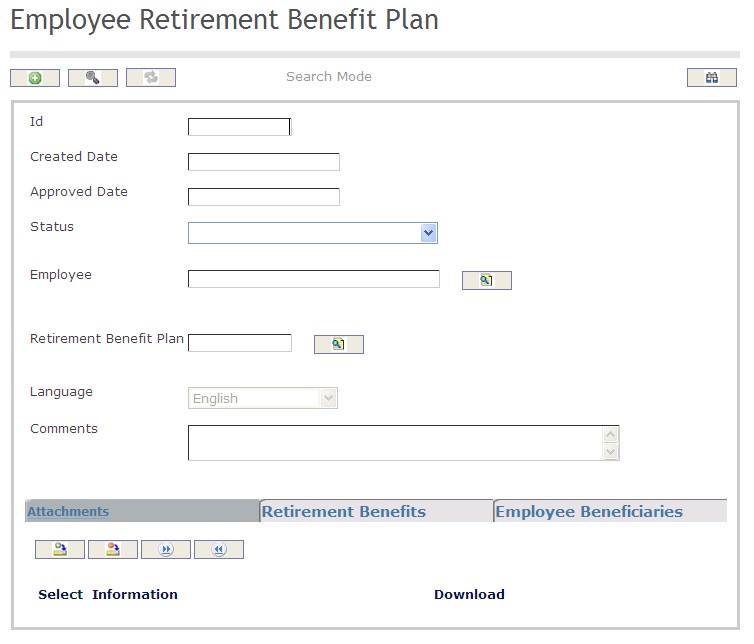
How to SEARCH:
- Enter the information to be used as retrieval criteria in the appropriate field (s). If you prefer to see a list of all Employee Retirement Benefit Plans, leave all fields blank.
- Click on the Find icon
 .
.
The Employee Retirement Benefit Plan screen includes the following fields:
| Report Fields | Description |
| ID | Unique identification code of the Employee Retirement Benefit Plan |
| Created Date | The date when the retirement benefit plan for the employee was created |
| Approved Date | The date when the employee retirement benefit plan for the employee was approved |
| Status | The current state of the Employee Retirement Benefit Plan |
| Employee | Includes all employee-related information. Searches can be performed by using retrieval criteria such as Employee code, name, hire date or value of any field of the Employee screen |
| Retirement Benefit Plan | A plan tailored specifically towards an employee's retirement compensation |
| Language | Language used |
| Comments | Relevant information related to this retirement benefit plan for the employee |
Create an Employee Retirement Benefit Plan
The Employee Retirement Benefit Plan screen is used to record the information on the particulars for the Retirement Benefits for a particular employee and the information related to the employee's beneficiaries.
To CREATE an Employee Retirement Benefit Plan, follow the steps below:
Navigation 
By default, you will be in Search Mode.
- Click on the New icon
 (you will then be in Insert Mode).
(you will then be in Insert Mode). - Enter the new Employee Retirement Benefit Plan information. Fields with an asterisk
 are mandatory fields.
are mandatory fields. - Enter the ID, as required.
- ID: Unique identification code of the Employee Retirement Benefit Plan
4. Created Date will be defaulted to the system date.
- Created Date: This date will tell us when the retirement benefit plan for the employee was created
5. Status will be automatically set to Created.
- Status: The current state of the Employee Retirement Benefit Plan
6. To enter the Employee, if required, click on the Lookup icon  , click on Find icon
, click on Find icon  to retrieve the Employee list, then select the Employee.
to retrieve the Employee list, then select the Employee.
- Employee: Includes all employee-related information. Searches can be performed by using retrieval criteria such as Employee code, name, hire date or value of any field of the Employee screen
7. To enter the Retirement Benefit Plan, if required, click on the Lookup icon  , click on Find icon
, click on Find icon  to retrieve the Retirement Benefit Plan list, then select the Retirement Benefit Plan.
to retrieve the Retirement Benefit Plan list, then select the Retirement Benefit Plan.
- Retirement Benefit Plan: a plan tailored specifically towards an employee's retirement compensation
8. Select the Language.
- Language: Language used
9. Enter Comments.
- Comments: Relevant information related to this retirement benefit plan for the employee
To ADD Attachments to the Employee Retirement Benefit Plan, if required:
1. Click on the New icon  under
under  to enter the Attachments (refer to Attachments for more information).
to enter the Attachments (refer to Attachments for more information).
2. Click on the Save and Return icon  to save the Attachments information and return to the Employee Retirement Benefit Plan screen, or click on the Discard icon
to save the Attachments information and return to the Employee Retirement Benefit Plan screen, or click on the Discard icon  to discard the Attachments entry and return to the Employee Retirement Benefit Plan.
to discard the Attachments entry and return to the Employee Retirement Benefit Plan.
3. Click the individual Select Checkbox (es), under  to select and de-select the Attachment (s), as required, or click the Select All icon
to select and de-select the Attachment (s), as required, or click the Select All icon  or Unselect All
or Unselect All  icon, to select or de-select all Attachments, if required.
icon, to select or de-select all Attachments, if required.
4. Click the Remove icon  to remove the selected Attachment, if required.
to remove the selected Attachment, if required.
To ADD Retirement Benefits to the Employee Retirement Benefit Plan, if required:
1. Click on the  tab and then click on the Lookup icon
tab and then click on the Lookup icon  , and enter the Retirement Benefits information, or leave the Retirement Benefits information blank to retrieve all Retirement Benefits.
, and enter the Retirement Benefits information, or leave the Retirement Benefits information blank to retrieve all Retirement Benefits.
2. Click the Find icon 
3. Click the individual Select Checkbox (es) to select and de-select the Retirement Benefits, as required.
4. Repeat steps 1, 2 and 3 for all required Retirement Benefits.
5. Click the Remove icon  to remove the selected Retirement Benefits information, if required.
to remove the selected Retirement Benefits information, if required.
6. Click the individual Select Checkbox (es) to select and de-select the Retirement Benefits, as required, or click the Select All icon  or Unselect All
or Unselect All  icon, to select all Retirement Benefits or de-select all Retirement Benefits, if required.
icon, to select all Retirement Benefits or de-select all Retirement Benefits, if required.
To ADD Employee Beneficiaries to the Employee Retirement Benefit Plan, if required:
1. Click on the New icon  under
under  to enter the Employee Beneficiaries (refer to Employee Beneficiaries for more information).
to enter the Employee Beneficiaries (refer to Employee Beneficiaries for more information).
2. Click on the Save and Return icon  to save the Employee Beneficiaries information and return to the Employee Retirement Benefit Plan screen, or click on the Discard icon
to save the Employee Beneficiaries information and return to the Employee Retirement Benefit Plan screen, or click on the Discard icon  to discard the Employee Beneficiaries entry and return to the Employee Retirement Benefit Plan.
to discard the Employee Beneficiaries entry and return to the Employee Retirement Benefit Plan.
3. Click the individual Select Checkbox (es), under  to select and de-select the Employee Beneficiary (s), as required, or click the Select All icon
to select and de-select the Employee Beneficiary (s), as required, or click the Select All icon  or Unselect All
or Unselect All  icon, to select or de-select all Employee Beneficiaries, if required.
icon, to select or de-select all Employee Beneficiaries, if required.
4. Click the Remove icon  to remove the selected Employee Beneficiary, if required.
to remove the selected Employee Beneficiary, if required.
Click on the Save icon  at the bottom of the Retirement Benefit page to save your new Employee Retirement Benefit Plan information. A window will appear to confirm.
at the bottom of the Retirement Benefit page to save your new Employee Retirement Benefit Plan information. A window will appear to confirm.
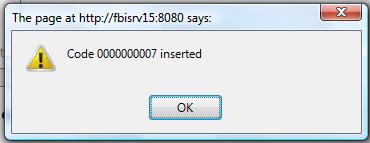
Employee Beneficiaries
Navigation  click the New Icon
click the New Icon under
under  ,
,
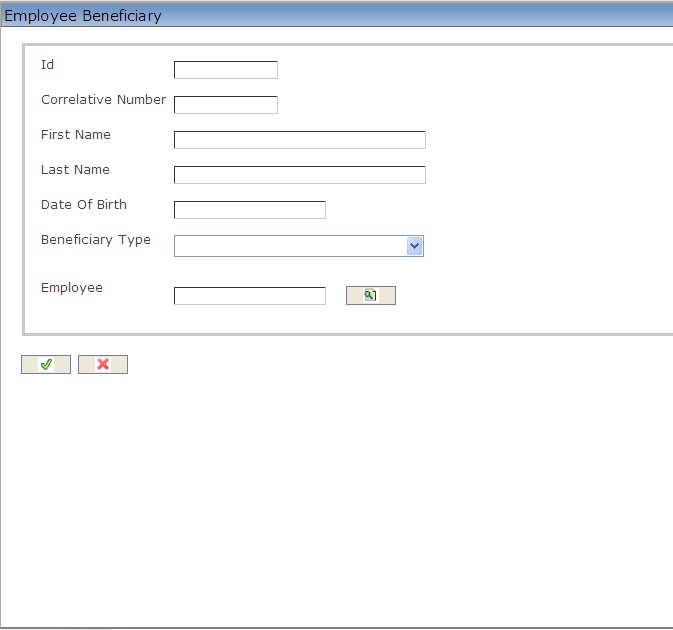
Create an Employee Beneficiary
Navigation  click the New Icon
click the New Icon under
under  ,
,
1. Enter the Employee Beneficiaries information.
2. Enter the ID, as required.
- ID: Unique identification code of the Employee Beneficiary
3. Enter the Correlative Number.
- Correlative Number: Determines the priority order for beneficiaries of the same type, this sequence will be required if more than one beneficiary of the same beneficiary type is entered
4. Enter the First Name.
- First Name: First name of the beneficiary
5. Enter the Last Name.
- Last Name: Last name of the beneficiary
6. Enter the Date of Birth.
- Date of Birth: The beneficiary's date of birth
7. Select a Beneficiary Type from the drop-down menu.
- Beneficiary Type: The beneficiary type associated to the beneficiary
8. To enter the Employee, if required, click on the Lookup icon  , click on the Find icon
, click on the Find icon  to retrieve the Employee list, then select the Employee.
to retrieve the Employee list, then select the Employee.
- Employee: For a benefit plan on execution, this attribute links the beneficiary to an employee entity in order to associate all the benefits for this beneficiary to a beneficiary type employee
9. Click on the Save and Return icon  to save the Employee Beneficiary information and return to the Employee Retirement Benefit Plan screen, or click on the Discard icon
to save the Employee Beneficiary information and return to the Employee Retirement Benefit Plan screen, or click on the Discard icon  to discard the Employee Beneficiary entry and return to the Employee Retirement Benefit Plan screen.
to discard the Employee Beneficiary entry and return to the Employee Retirement Benefit Plan screen.
Delete an Employee Retirement Benefit Plan
The Employee Retirement Benefit Plan screen is used to record the information on the particulars for the Retirement Benefits for a particular employee and the information related to the employee's beneficiaries.
To DELETE an Employee Retirement Benefit Plan, follow the steps below:
Note: the status must be Created in order to delete.
Navigation 
By default, you will be in Search Mode.
- Find the Employee Retirement Benefit Plan you want to Delete
- Enter the information to be used as retrieval criteria in the appropriate field(s). If you prefer to see all Employee Retirement Benefit Plans, leave all fields blank.
- Click Find

- Select the Employee Retirement Benefit Plan you want to Delete
- Click on the Delete icon

- A window will appear asking you to confirm

- Click OK to confirm and delete the Employee Retirement Benefit Plan.
- A window will be displayed confirming the Employee Retirement Benefit Plan has been deleted
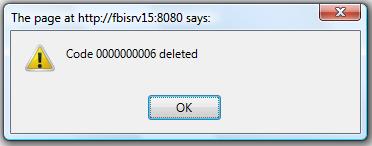
To Verify that the Employee Retirement Benefit Plan has been Deleted:
- Click on the Search icon

- Enter the Employee Retirement Benefit Plan information
- Click on the Find icon

- The window will appear

Modify an Employee Retirement Benefit Plan
The Employee Retirement Benefit Plan screen is used to record the information on the particulars for the Retirement Benefits for a particular employee and the information related to the employee's beneficiaries.
To MODIFY an Employee Retirement Benefit Plan, follow the steps below:
Navigation 
By default, you will be in Search Mode.
- Enter the information to be used as retrieval criteria in the appropriate field(s).
If you prefer to see the list of all Employee Retirement Benefit Plans, leave all fields blank. - Click on the Find icon
 . The list of Employee Retirement Benefit Plans meeting the retrieval criteria will appear.
. The list of Employee Retirement Benefit Plans meeting the retrieval criteria will appear. - Click on the Employee Retirement Benefit Plan you want to modify.
You will then be in Update/Delete Mode. - Make the necessary modifications. To add or remove Attachments, refer to Attachments. Too add or remove Employee Beneficiaries, refer to Employee Beneficiaries.
- Click on the Update icon
 at the bottom of the screen to save your modifications. A window will appear to confirm the modification. Click OK to confirm.
at the bottom of the screen to save your modifications. A window will appear to confirm the modification. Click OK to confirm. 
Note:If an Employee Benefit Retirement Plan has the status Approved, the changes will not be saved immediately. A change request will be generated and if the request is approved, then the changes will be saved.
Workflow Transitions for Employee Retirement Benefit Plan
This screen is used to record the information on the particulars for the Retirement Benefits for a particular employee and the information related to the employee's beneficiaries.
Navigation 
To REQUEST APPROVAL, APPROVE, REJECT, or CANCEL an Employee Retirement Benefit Plan, follow the steps below:
By default, you will be in Search Mode.
1. Find the Employee Retirement Benefit Plan which you would like to make a status change on.
- Enter Code, Description or other Attributes of the Employee Retirement Benefit Plan
- Click on the Find icon

2. Select the Employee Retirement Benefit Plan you would like to Request for Approval, Approve, Reject, or Cancel.
3. Select your choice from the drop down list in the Transition field.

4. A Transition Window will be displayed confirming the Transition. Add a description in the Step Note in the Transition Window.

5. Click on the Finish Icon  to complete the Transition transaction, or click the Discard Icon
to complete the Transition transaction, or click the Discard Icon  to abort the transition.
to abort the transition.
6. Upon clicking the Finish Icon  a window will be displayed confirming the Employee Retirement Benefit Plan Workflow Transition was executed.
a window will be displayed confirming the Employee Retirement Benefit Plan Workflow Transition was executed.

7. Click Okay on the Workflow Transition Executed window. The Employee Retirement Benefit Plan status is now set to whichever choice was selected.
Retirement Request
Overview
This form is used to apply for retirement. It is the first part of the retirement process. The user must enter and select all required information to complete the Retirement Request. At the bottom of the form, the user can click on the tab titled View Calculation Results to analyze the results administered through the Retirement Request process.
Navigation


How to SEARCH:
- Enter the information to be used as retrieval criteria in the appropriate field (s). If you prefer to see a list of all Retirement Requests, leave all fields blank.
- Click on the Find icon
 .
.
The Retirement Request screen includes the following fields:
| Report Fields | Description |
| ID | Unique identification code of the Retirement Request |
| File Number | Physical File Number associated to this request |
| Retirement Status | The current state of the Retirement Request. The first step is to request validation of the Retirement Request from the HR officer. If approved, the Retirement Request continues to the next workflow step. If it is not approved, the Retirement Request is cancelled |
| Retirement Request Mode | Allows the user to view whether the Retirement Request was generated by a batch file (Automatic) or added manually (Manual) by a user |
| Issue Date | Automatically assigned by the System, this is the date when this retirement request has been issued |
| Effective Date | The effective date for this retirement request |
| Approved Date | The date when this retirement request has been approved. System generated when it returns as approved |
| Calculation Date | Default value is left blank and will be automatically updated with the System date |
| Retirement Type | The retirement type is a way of defining different retirements. As an example, an employee may retire because of death so there will be a death retirement type. Also, the employee may retire because he/she has reached the retirement age, which would be a mandatory retirement type |
| Applicant | The employee that is applying for this retirement request |
| Effective Assignment | When adding a new request, this will default to the last assignment of this employee. The user can change and select a different assignment. When selecting a new assignment, Salary Transition should change automatically and display the cost item scale step of the latest salary transition of the new assignment selected |
| Salary Transition | Should default to the last effective salary transitions of the assignment from Effective Assignment. This is a read-only function. The user needs to see group-subgroup-level, step, and the amount from salary transition is not the primary key |
| Requested By | The employee who requested this retirement request |
| Retirement Pay Code | The retirement pay code selected will be used when the employee assignment is created, once the retirement request is approved. Also, the pay code is used to group employees for payroll purposes |
| Calculated Consecutive Periods | The value which was calculated by the system for the Retirement Request. This value includes the periods of service that the employee has worked consecutively |
| Manual Consecutive Periods | The value which can be manually entered to override the Calculated Consecutive Periods value. If not entered, the calculated amount will be used |
| Calculated Periods | The value which was calculated by the system for the Retirement Request. This value includes the periods of service that the employee has worked |
| Manual Periods | The value which can be manually entered to override the Calculated Consecutive Periods value. If not entered, the calculated amount will be used |
| Language | Language used |
| Comments | Comments related to this retirement request |
Create a Retirement Request (2nd proposal)
 | The Retirement Request screen requires the user to manually add a Retirement Request to a specific employee within the organization. |
Navigation
By default, you will be in Search Mode. To CREATE a Retirement Request, follow the steps below:
i. Click on the New icon ii. Click on the Save and Return icon iii. Click the individual Select Checkbox(es), under iv. Click the Remove icon v. Repeat steps (i) to (iv) for all additional Attachments. 4. Click on the Save icon
ADDITIONAL INSTRUCTIONS FOR FIELDS/TABS
|
Create a Retirement Request
 | The Retirement Request screen requires the user to manually add a Retirement Request to a specific employee within the organization. |
To CREATE a Retirement Request, follow the steps below: Navigation
By default, you will be in Search Mode.
To ADD Attachments to the Retirement Request, if required: 1. Click on the New icon 2. Click on the Save and Return icon 3. Click the individual Select Checkbox (es), under 4. Click the Remove icon 5. Repeat steps 1 to 4 for all required Attachments.
Retirement Benefits Retirement Calculation Results Click on the Save icon
|
Retirement Calculation Results
Navigation  click the New Icon
click the New Icon under
under  ,
,
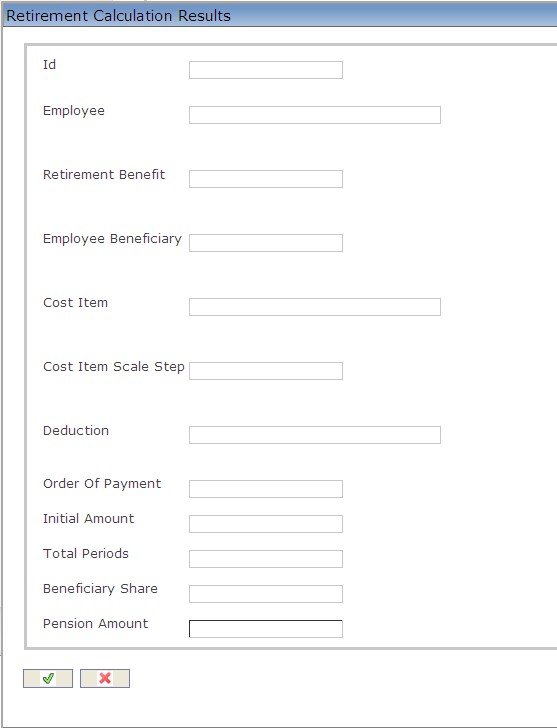
Note:The results can be viewed with this form. The pension amount is modifiable if it is set as a manual benefit.
Delete a Retirement Request
 | The Retirement Request screen requires the user to manually add a Retirement Request to a specific employee within the organization. Note: Only a Retirement Request that has the status Created is allowed to be deleted. If you need to eliminate a Retirement Request once it has started its workflow, the only option is to change its Retirement Status to Cancelled. |
To DELETE a Retirement Request, follow the steps below: Navigation
By default, you will be in Search Mode.
To Verify that the Retirement Request has been Deleted:
|
Modify a Retirement Request
The Retirement Request screen requires the user to manually add a Retirement Request to a specific employee within the organization.
To MODIFY a Retirement Request, follow the steps below:
Note:A Retirement Request can only be modified if the status is set to Created or Validation Approved. Depending on the status, certain fields will be read only.
Navigation 
By default, you will be in Search Mode.
- Enter the information to be used as retrieval criteria in the appropriate field(s).
If you prefer to see the list of all Retirement Requests, leave all fields blank. - Click on the Find icon
 . The list of Retirement Requests meeting the retrieval criteria will appear.
. The list of Retirement Requests meeting the retrieval criteria will appear. - Click on the Retirement Request you want to modify.
You will then be in Update/Delete Mode. - Make the necessary modifications. To add or remove Attachments, refer to Attachments. Too add or remove Retirement Calculation Results, refer to Retirement Calculation Results.
- Click on the Update icon
 at the bottom of the screen to save your modifications. A window will appear to confirm the modification. Click OK to confirm.
at the bottom of the screen to save your modifications. A window will appear to confirm the modification. Click OK to confirm. 
Once a Retirement Request is Approved, the retiree will have a new assignment and automatic cost items created for payroll purposes. The results also appear in Retirement Summary and Details.
Workflow Transitions for Retirement Request
Validation of Retirement Request
Overview
The Retirement Request screen requires the user to manually add a Retirement Request to a specific employee within the organization.
Navigation 
To Request Validation to a Retirement Request, follow the steps below:
By default, you will be in Search Mode.
1. Find the Retirement Request which you would like to change status to Validation Requested.
Note: In order to Request Validation for a Retirement Request Status must be Created.
Note: Once Validation Requested, changes to the Retirement Request are no longer permitted.
Note: Once Validation is Requested there are two possibilities, Approve Validation, Reverse Validation Approval, Reject Validation, or Cancel Validation.
- Enter Code, Description or other Attributes of the Retirement Request.
- Click on the Find icon

2. Select the Retirement Request you would like to VALIDATE.
3. Select "Request Validation" from the drop down list in the Transition field.

4. A Transition Window will be displayed confirming the Transition. If necessary add a description in the Step Note in the Transition Window.

5. Click on the Finish Icon  to complete the Transition transaction, or click the Discard Icon
to complete the Transition transaction, or click the Discard Icon  to abort the transition.
to abort the transition.
6. Upon clicking the Finish Icon  a window will be displayed confirming the Retirement Request Workflow Transition was executed.
a window will be displayed confirming the Retirement Request Workflow Transition was executed.

7. Click Okay on the Workflow Transition Executed window. The Retirement Request status is now set to Validation Requested.
To APPROVE a VALIDATION REQUEST, follow the steps below:
Navigation 
By default, you will be in Search Mode.
1. Find the Retirement Request which you would like to change status to Validation Approved.
Note: In order to Approve Validation for a Retirement Request Status must be Validation Requested.
Note: Once Retirement Request Validation is Approved, the next action is to either Reverse Validation Approval or Calculate Pension.
- Enter Code, Description or other Attributes of the Retirement Request.
- Click on the Find icon

2. Select the Retirement Request you would like to change APPROVE VALIDATION.
3. Select "Approve Validation" from the drop down list in the Transition field.

4. Repeat Steps 4-7, from above. The Retirement Request status is now set to Validation Approved.
To REVERSE VALIDATION APPROVAL, follow the steps below:
Navigation 
By default, you will be in Search Mode.
1. Find the Retirement Request which you would like to change status to Request Validation.
Note: In order to Reverse Validation Approval the Retirement Request Status must be Validation Approved.
- Enter Code, Description or other Attributes of the Retirement Request.
- Click on the Find icon

2. Select the Retirement Request you would like to change VALIDATION REQUESTED.
3. Select "Reverse Validation Approval" from the drop down list in the Transition field.

4. Repeat Steps 4-7, from above. The Retirement Request status is now set to Validation Requested.
To REJECT a VALIDATION REQUEST, follow the steps below:
Navigation 
By default, you will be in Search Mode.
1. Find the Retirement Request which you would like to change status to Validation Rejected.
Note: In order to Reject Validation for a Retirement Request Status must be Validation Requested.
- Enter Code, Description or other Attributes of the Retirement Request.
- Click on the Find icon

2. Select the Retirement Request you would like to change REJECT VALIDATION.
3. Select "Reject Validation" from the drop down list in the Transition field.

4. Repeat Steps 4-7, from above. The Retirement Request status is now set to Validation Rejected.
Calculate Pension
Overview
The Retirement Request screen requires the user to manually add a Retirement Request to a specific employee within the organization.
Navigation 
To Calculate Pension to a Retirement Request, follow the steps below:
By default, you will be in Search Mode.
1. Find the Retirement Request which you would like to change status to Calculated.
Note: In order to calculated pension retirement request status must be: Validation Approved, or Calculated.
Note: Once Pension is Calculated, the next step is to REQUEST APPROVAL. Following, the Request for Approval maybe: APPROVED, REJECTED, or CANCELED.
Note: Once validated, calculation is done according to the formulas. Calculations can be preformed automatically calculation or entered manually. In addition, records are created in retirement calculation results or users can enter manual amounts.
- Enter Code, Description or other Attributes of the Retirement Request.
- Click on the Find icon

2. Select the Retirement Request you would like to CALCULATE.
3. Select "Calculate Pension" from the drop down list in the Transition field.

4. A Transition Window will be displayed confirming the Transition. If necessary add a description in the Step Note in the Transition Window.

5. Click on the Finish Icon  to complete the Transition transaction, or click the Discard Icon
to complete the Transition transaction, or click the Discard Icon  to abort the transition.
to abort the transition.
6. Upon clicking the Finish Icon  a window will be displayed confirming the Retirement Request Workflow Transition was executed.
a window will be displayed confirming the Retirement Request Workflow Transition was executed.

7. Click Okay on the Workflow Transition Executed window. The Retirement Request status is now set to Calculated.
To MODIFY a Pensions Calculation, follow the steps below:
1. Select to Pension you wish to calculate from the list available.
2. Make desired changes in the appropriate fields.
3. Click the CALCULATE icon to calculate results.
3. Select the  tab. Select the Pension to View. The following screen will appear:
tab. Select the Pension to View. The following screen will appear:
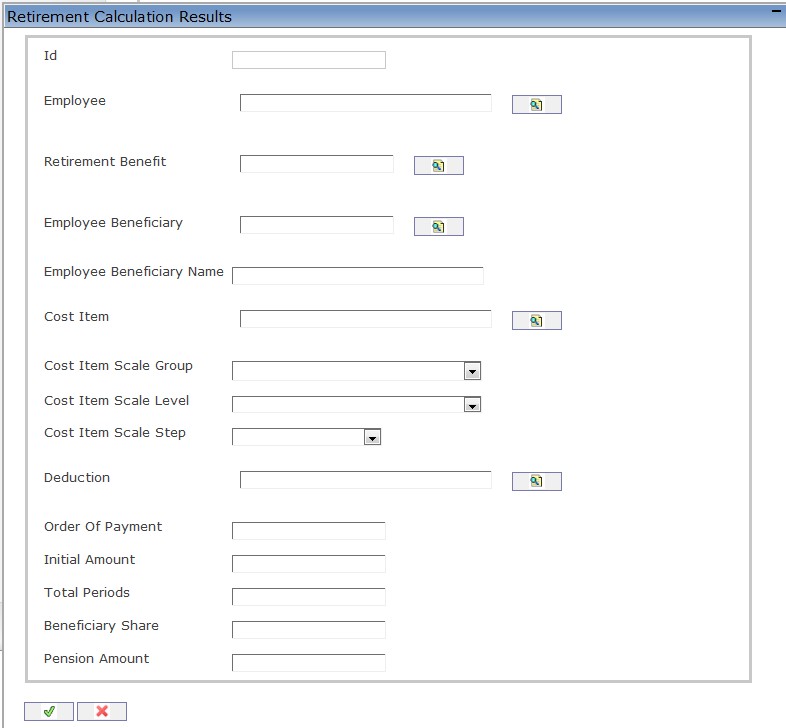
The changes are reflected in the Results window.
To Request Approval to a Pensions Calculation, follow the steps below:
Navigation 
By default, you will be in Search Mode.
1. Find the Retirement Request which you would like to change status to Validation Requested.
Note: In order to Request Approval for a Pensions Calculation the Retirement Request Status must be Calculated.
Note: Once Validation is Requested there are two possibilities, Approved, Rejected, or Cancel.
- Enter Code, Description or other Attributes of the Retirement Request.
- Click on the Find icon

2. Select the Retirement Request you would like to Request an Approval for.
3. Select "Request Approval" from the drop down list in the Transition field.

4. Repeat steps 4-7. The Retirement Request status is now set to Approval Requested.
To APPROVE an APPROVAL REQUEST for a PENSION CALCULATION, follow the steps below:
Navigation 
By default, you will be in Search Mode.
1. Find the Retirement Request which you would like to change status to Approved.
Note: In order to Approve a Pension Calculation a Retirement Request Status must be Approval Requested.
Note: Once Pensions Calculated is APPROVED, there are no further steps.
Note: Once Retirement Request is approved, the follow will occur:
- Records are created in the following entities Retirement Summary, Employee Assignment.
- The system will create Automatic Cost Items and Automatic Deductions. This retirement benefit will be included in the payroll calculation.
- Enter Code, Description or other Attributes of the Retirement Request.
- Click on the Find icon

2. Select the Retirement Request you would like to change APPROVAL REQUESTED.
3. Select "Request Approval" from the drop down list in the Transition field.

4. Repeat Steps 4-7. The Retirement Request status is now set to Approved.
To REJECT APPROVAL REQUEST for a PENSION CALCULATION, follow the steps below:
Navigation 
By default, you will be in Search Mode.
1. Find the Retirement Request which you would like to change status to Rejected.
Note: To Reject an Approval Request for a Pension Calculation, Retirement Request Status must be Approval Requested.
- Enter Code, Description or other Attributes of the Retirement Request.
- Click on the Find icon

2. Select the Retirement Request you would like to change REJECTED.
3. Select "Reject " from the drop down list in the Transition field.

4. Repeat Steps 4-7 above. The Retirement Request status is now set to Rejected.
Cancel a Retirement Request
Overview
The Retirement Request screen requires the user to manually add a Retirement Request to a specific employee within the organization.
To CANCEL a Retirement Request, follow the steps below:
Navigation 
By default, you will be in Search Mode.
1. Find the Retirement Request which you would like to change status to Canceled.
Note: To Cancel a Retirement Request Status must be Request Validation, Validation Approved, Calculated, and Approval Requested.
- Enter Code, Description or other Attributes of the Retirement Request.
- Click on the Find icon

2. Select the Retirement Request you would like to change to CANCELED.
3. Select "Cancel " from the drop down list in the Transition field.

4. A Transition Window will be displayed confirming the Transition. If necessary add a description in the Step Note in the Transition Window.

5. Click on the Finish Icon  to complete the Transition transaction, or click the Discard Icon
to complete the Transition transaction, or click the Discard Icon  to abort the transition.
to abort the transition.
6. Upon clicking the Finish Icon  a window will be displayed confirming the Retirement Request Workflow Transition was executed.
a window will be displayed confirming the Retirement Request Workflow Transition was executed.

7. Click Okay on the Workflow Transition Executed window. The Retirement Request status is now set to Canceled.
Generate Automatic Retirement Request
Overview
The System has a batch process that is scheduled to run on a specific date which detects ahead of time, the employees who will reach the mandatory age of retirement. This process will create automatically a retirement request that will then be processed the same way as a manual request. The menu option, is there so a user can force this batch process to be executed at any given moment.
The user must specify the period the System should check to see if any employees will reach the age of retirement. As an example if the user enters start date as August 1, 2011 and an end date August 31, 2011, The System will check for anyone who will be the age of retirement and is not already retired.
Navigation


How to SEARCH:
- Enter the information to be used as retrieval criteria in the appropriate field(s). If you prefer to see a list of all Automatic Retirement Requests Generated, leave all fields blank.
- Click on the Find icon
 .
.
The Generate Automatic Retirement Request screen includes the following fields:
| Report Fields | Description |
| Start Date | Start Date that the System will use for searching employees that have retirement age, but haven't retired yet. |
| End Date | End Date that the System will use for searching employees that have retirement age, but haven't retired yet. |
Retirement Summary
Overview
Retirement Summary shows the results of the retirement request along with the results of the calculation.
Navigation

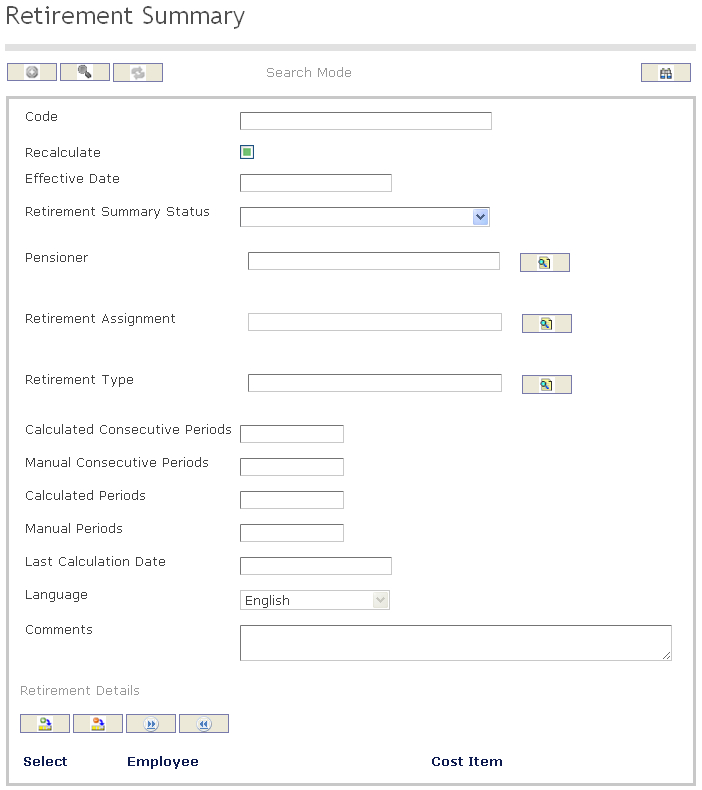
How to SEARCH:
- Enter the information to be used as retrieval criteria in the appropriate field (s). If you prefer to see a list of all Retirement Summary, leave all fields blank
- Click on the Find icon

The Retirement Summary screen includes the following fields:
Field | Definition |
| Code | This code is System generated when a retirement request has gone through all the stages and the calculations have been approved |
| Recalculate | If changes occur such as a life certicate is renewed, the System needs to recalculate but does not need to get it approved again, so no manual intervention is required. The field Recalculate will then be automatically set by the System to let the application know that the retirement details attached to this summary need to be recalculated |
Effective Date | The effective date for the retirement request |
Retirement Summary Status | Describes the status assigned to a retirement summary. The status can be cancelled, pending, completed, etc. |
Pensioner | The employee that is applying for the retirement request |
Retirement Assignment | This retirement assignment displays the assignment that was created by the retirement module in order to pay the retirement benefits |
| Retirement Type | Contains a catalogue of the different retirement types available for a particular implementation |
| Calculated Consecutive Periods | Automatically calculated retirement consecutive periods |
| Manual Consecutive Periods | Manually calculated retirement consecutive periods |
| Calculated Periods | The number of periods being calculated |
| Manual Periods | These are the periods of service that a user can enter if they do not agree with the periods of service that were calculated by the System |
| Last Calculation Date | This date displays the last time the retirement was calculated |
| Language | This is the language of the description entered |
| Comments | These are comments added in regards to the retirement request |

 is a read only tab. It will display the employee's retirement benefits according to their plan.
is a read only tab. It will display the employee's retirement benefits according to their plan. is a read only tab. It will display the results once the request has been calculated.
is a read only tab. It will display the results once the request has been calculated.